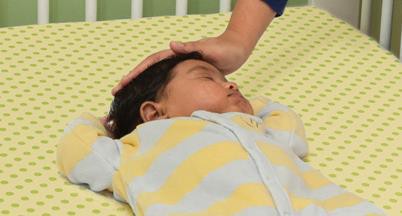27 Sleep
A newborn typically sleeps approximately 16.5 hours per 24-hour period. This is usually polyphasic sleep in that the infant is accumulating the 16.5 hours over several sleep periods throughout the day (Salkind, 2005). The infant is averaging 15 hours per 24-hour period by one month, and 14 hours by 6 months. By the time children turn two, they are averaging closer to 10 hours per 24 hours. Additionally, the average newborn will spend close to 50% of the sleep time in the Rapid Eye Movement (REM) phase, which decreases to 25% to 30% in childhood.[1]
Sudden Infant Death Syndrome and Safe Sleep
Sudden Infant Death Syndrome (SIDS) is identified when the death of a healthy infant occurs suddenly and unexpectedly, and medical and forensic investigation findings (including an autopsy) are inconclusive. SIDS is the leading cause of death in infants 1 to 12 months old, and approximately 1,500 infants died of SIDS in 2013 (CDC, 2015). Because SIDS is diagnosed when no other cause of death can be determined, possible causes of SIDS are regularly researched. One leading hypothesis suggests that infants who die from SIDS have abnormalities in the area of the brainstem responsible for regulating breathing (Weekes- Shackelford & Shackelford, 2005).[2]

Risk Factors
Babies are at higher risk for SIDS if they:
- Sleep on their stomachs
- Sleep on soft surfaces, such as an adult mattress, couch, or chair or under soft coverings
- Sleep on or under soft or loose bedding
- Get too hot during sleep
- Are exposed to cigarette smoke in the womb or in their environment, such as at home, in the car, in the bedroom, or other areas
- Sleep in an adult bed with parents, other children, or pets; this situation is especially dangerous if:
- The adult smokes, has recently had alcohol, or is tired.
- The baby is covered by a blanket or quilt.
- The baby sleeps with more than one bed-sharer.
- The baby is younger than 11 to 14 weeks of age.
Reducing the Risks
There have been dramatic improvements in reducing baby deaths during sleep since the 1990s, when recommendations were introduced to place babies on their back for sleep. However, since the late 1990s, declines have slowed.
In 2012, the Back to Sleep campaign became the Safe to Sleep campaign. Safe to Sleep aims to educate all caregivers about SIDS and safe sleep practices. Current recommendations to reduce the risk of SIDS and other sleep related causes of infant death:
- Always place baby on his or her back to sleep (for naps and at night).
- Use a firm and flat surface.
- Use only a tight fitting sheet on the sleep surface; no other bedding or soft items in the sleep area.
- Breastfeed.
- Share your room with a baby, but on a separate surface designed for infants (not your bed).
- Do not put soft objects, toys, crib bumpers, or loose bedding under, over, or anywhere near baby’s sleep area.
- Do no smoke during pregnancy or allow smoking around baby.
- Consider giving baby a pacifier.
- Do not let baby get too hot during sleep.
- Get regular health care (including vaccines).
- Avoid products that go against safe sleep recommendations, especially those that claim to prevent or reduce the risk of SIDS.
- Do not use heart or breathing monitors to reduce the risk of SIDS.[3]
- Lifespan Development: A Psychological Perspective by Martha Lally and Suzanne Valentine-French is licensed under CC BY-NC-SA 3.0 ↵
- Lifespan Development: A Psychological Perspective by Martha Lally and Suzanne Valentine-French is licensed under CC BY-NC-SA 3.0 ↵
- Ways to Reduce the Risk of SIDS and Other Sleep-Related Causes of Infant Death by the CDC is in the public domain ↵

